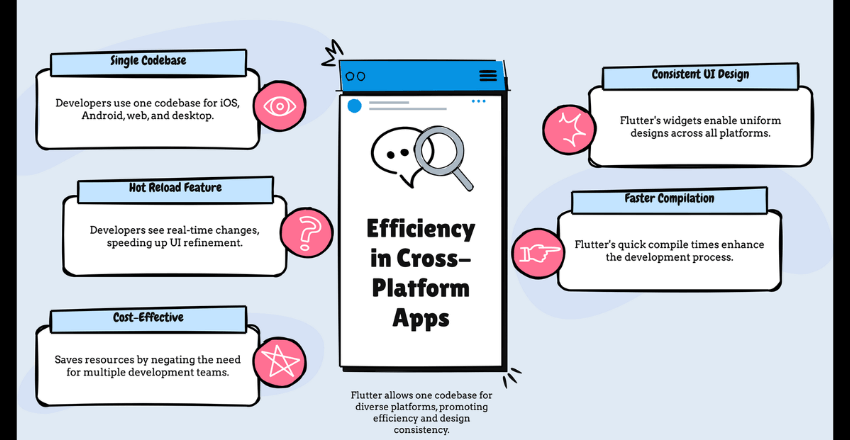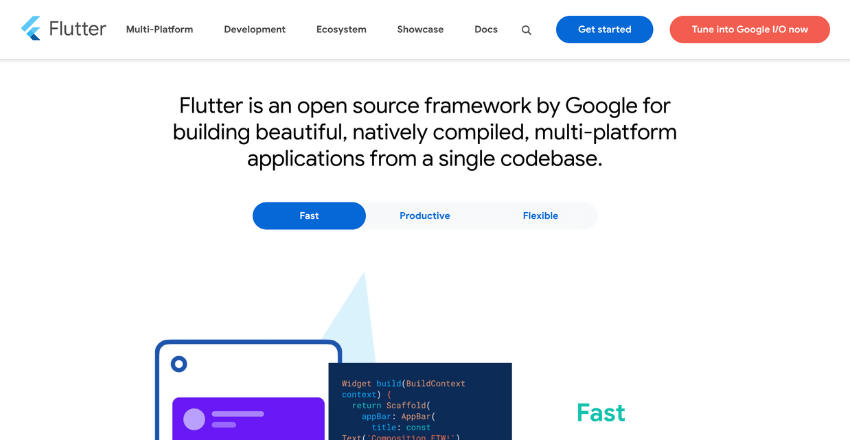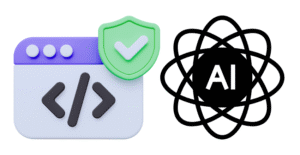Cross-Platform App Development with Flutter is a game-changer for developers looking to create versatile apps that can run seamlessly on various platforms. With Flutter, developers can maintain a single codebase and deploy their apps on mobile (iOS and Android), web, desktop (Windows, macOS, and Linux), and even embedded devices. Flutter’s powerful UI capabilities and the use of the Dart language make it a preferred choice for cross-platform app development.
Benefits of Flutter for Cross-Platform App Development

Flutter offers a range of benefits for cross-platform app development, enabling developers to create efficient and visually appealing applications across different platforms. With Flutter, developers can maintain a single codebase and deploy it to multiple platforms, including mobile (iOS and Android), web, desktop (Windows, macOS, and Linux), and even embedded devices. This eliminates the need for rewriting code for each platform, saving time and effort.
One of the key advantages of Flutter is its performant rendering engine, which ensures smooth and responsive app performance across platforms. Flutter also provides developers with a wide range of customizable designs through its extensive collection of widgets. These widgets allow developers to create intuitive and visually appealing user interfaces for their applications.
Another notable benefit of Flutter is its use of the Dart language. Dart is optimized for fast app development, making it easier for developers to write clean and efficient code. Furthermore, Flutter’s fast compilation times and the hot reload feature greatly enhance the development workflow, allowing developers to see changes in real-time while making modifications to the code.
Trusted by Google and widely adopted by developers worldwide, Flutter has become a go-to framework for cross-platform app development. Its simplicity and versatility have made it popular among developers looking to create applications that work seamlessly across various platforms. Despite some limitations, such as larger file sizes and limited access to third-party libraries, the benefits of Flutter outweigh these challenges, making it a reliable choice for developers.
| Key Benefits of Flutter for Cross-Platform App Development: |
|---|
| Efficiently deploy apps across multiple platforms |
| Performant rendering engine for smooth app performance |
| Customizable designs through a wide range of widgets |
| Use of the Dart language for fast and efficient development |
| Fast compilation times and hot reload feature for enhanced development workflow |
| Trusted by Google and widely adopted by developers worldwide |
The Power of Flutter and Dart

Flutter and Dart provide developers with a powerful combination of features, including fast compilation, a hot reload feature, and a set of developer-friendly tools that enhance productivity. Flutter’s fast compilation times contribute to a smooth development workflow, allowing developers to make changes and see their effects instantly. With its hot reload feature, developers can make modifications to the codebase and see the results immediately, saving valuable time during the development process.
To further enhance productivity, Flutter offers a range of developer-friendly tools. These tools simplify the development process by providing features such as code completion, debugging tools, and a rich set of widgets for building beautiful user interfaces. Flutter’s widget-based architecture allows for highly customizable designs that look and feel native on every platform, ensuring a consistent and visually appealing user experience.
Fast Compilation and Hot Reload
One of the key advantages of using Flutter is its fast compilation times. This means that developers can iterate quickly and see their changes reflected immediately, without any significant lag. This speed not only improves efficiency but also allows for a more seamless development experience. Additionally, the hot reload feature in Flutter makes it incredibly easy to experiment with different design elements and functionalities, enabling developers to fine-tune their apps in real-time.
Developer-Friendly Tooling
Flutter’s developer-friendly tooling is another aspect that sets it apart from other cross-platform frameworks. The Flutter SDK comes with a suite of tools that make the development process more efficient and straightforward. These tools include code completion, which speeds up the coding process by automatically suggesting code snippets and completing code blocks. Additionally, Flutter provides powerful debugging tools that help developers identify and fix issues quickly.
Furthermore, Flutter offers a vast collection of pre-built widgets that can be easily customized to suit the app’s needs. These widgets can be used to create stunning user interfaces with minimal effort, saving developers valuable time and resources.
| Advantages of Flutter and Dart |
|---|
| Fast compilation times |
| Hot reload feature for instant changes |
| Developer-friendly tooling with code completion and debugging tools |
| Rich set of customizable widgets for beautiful user interfaces |
The Reach of Flutter: Supported Platforms
Flutter enables developers to build apps that can run on multiple platforms, including mobile (iOS and Android), web, desktop (Windows, macOS, Linux), and even embedded devices. Its versatility allows developers to target a wide range of platforms, expanding the reach of their apps.
Mobile Platforms
Flutter excels in mobile app development, supporting both iOS and Android platforms. By leveraging Flutter’s powerful UI capabilities and fast compilation times, developers can create visually appealing and performant apps that run seamlessly on both operating systems.
Web Platforms
With Flutter, developers can extend their apps to the web. Flutter’s single codebase and customizable designs enable the creation of cross-platform web applications that provide a consistent user experience across different browsers and devices.
Desktop Platforms
Flutter also caters to desktop app development, supporting platforms such as Windows, macOS, and Linux. By utilizing Flutter’s rendering engine and its rich set of widgets, developers can build native-like desktop applications that run smoothly on multiple operating systems.
Embedded Devices
In addition to mobile, web, and desktop platforms, Flutter can also be used to develop apps for embedded devices. This allows developers to build innovative solutions for a wide range of devices, such as IoT devices, smart TVs, and automotive interfaces.
| Platform | Supported By Flutter |
|---|---|
| Mobile | Yes (iOS and Android) |
| Web | Yes |
| Desktop | Yes (Windows, macOS, Linux) |
| Embedded Devices | Yes |
Flutter’s wide platform support opens up countless possibilities for developers, allowing them to reach a broader audience and maximize the impact of their apps.
Simplifying Cross-Platform Development

Flutter simplifies cross-platform development, helping developers save time and costs by using a single codebase for multiple platforms, while delivering an exceptional user experience. With Flutter, developers can create apps that work seamlessly across mobile (iOS and Android), web, desktop (Windows, macOS, and Linux), and even embedded devices. This versatility allows companies to reach a broader audience without the need for separate development teams and resources.
One of the key advantages of Flutter is its ability to maintain a consistent UI design across different platforms. Flutter offers customizable designs for every screen, ensuring a visually appealing and engaging user experience. This is made possible by Flutter’s extensive library of widgets, which can be easily tailored to fit the specific requirements of each platform. Developers can create stunning apps with smooth animations and responsive layouts, providing a polished and professional appearance.
Furthermore, Flutter’s hot reload feature and fast compilation times significantly improve the development workflow. The hot reload feature allows developers to instantly see changes in the app during the development process, making it easier to iterate and refine the user interface. Flutter’s fast compilation times contribute to an efficient development cycle, reducing waiting times and enabling developers to iterate quickly.
“Flutter simplifies cross-platform development by providing a single codebase, customizable UI designs, and faster development cycles, resulting in significant time and cost savings.”
While there are some limitations to consider, such as larger file sizes compared to other platforms and limited access to certain third-party libraries, the benefits of Flutter far outweigh these drawbacks. Flutter’s extensive documentation and active developer community provide solutions and workarounds for these challenges, ensuring that developers can overcome them effectively.
Flutter streamlines cross-platform development by offering a single codebase, powerful UI capabilities, and efficient development tools. By leveraging Flutter, companies can save time and costs, while delivering high-quality apps with exceptional user experiences across multiple platforms.
| Advantages of Flutter for Cross-Platform Development: |
|---|
| Single codebase for multiple platforms |
| Consistent and customizable UI designs |
| Fast compilation and hot reload feature |
| Extensive documentation and active developer community |
Google’s Trust and Developer Community
Flutter is trusted by Google and has gained significant popularity among developers worldwide, establishing itself as a leading choice for cross-platform app development. Its versatility and powerful features have contributed to its widespread adoption and reputation in the development community.
Developers appreciate the support and commitment that Google provides to Flutter. With Google as its driving force, Flutter benefits from continuous updates, improvements, and a strong development roadmap. This ensures that developers always have access to the latest advancements in cross-platform app development.
In addition to Google’s trust, Flutter has built a large and vibrant developer community. Developers worldwide have recognized the potential of Flutter and actively contribute to its growth through open-source projects, sample apps, and tutorials. This collaborative environment fosters innovation and knowledge sharing, empowering developers to overcome challenges and explore new possibilities.
The Power of Community
Flutter’s developer community is known for its active engagement, providing valuable resources and support to both beginners and experienced developers. Online forums, like the Flutter subreddit and Stack Overflow, serve as platforms for developers to ask questions, share insights, and collaborate on solutions.
The Flutter community also organizes conferences, meetups, and hackathons, offering opportunities for developers to network, learn from experts, and showcase their work. These events foster a sense of belonging and camaraderie within the community, making Flutter an inclusive and collaborative ecosystem.
| Benefits of Flutter’s Developer Community | Examples |
|---|---|
| Access to expert advice and guidance | The Flutter community offers mentorship programs and support groups to help developers navigate challenges and optimize their app development process. |
| Sharing of best practices and code snippets | Developers frequently share their experiences, tips, and reusable code snippets, accelerating the learning curve for others. |
| Collaboration on open-source projects | The community actively contributes to open-source projects, expanding the range of available libraries, tools, and functionalities for Flutter developers. |
With Google backing Flutter and a vibrant developer community, the future of cross-platform app development looks promising. Developers can confidently rely on Flutter’s proven capabilities, extensive resources, and the ongoing support of a dedicated community to create exceptional, cross-platform applications.
Limitations of Flutter
While Flutter offers numerous advantages, it’s important to consider its limitations, including larger file sizes and potential limitations in accessing third-party libraries.
One notable limitation of Flutter is the larger file size compared to other platforms. This can impact app performance, especially for users with limited storage capacity on their devices. However, it’s worth noting that the performance benefits and rich UI capabilities of Flutter often outweigh this drawback. Developers can optimize their app’s file size by removing unnecessary dependencies and assets, ensuring a smooth user experience without compromising on functionality.
Another limitation is the potential limitations in accessing third-party libraries. While Flutter has a growing ecosystem of libraries and packages available, it may not have the same extensive selection as more established frameworks. This can require developers to find alternative solutions or build custom functionalities, adding to development time and effort. However, Flutter’s community is actively developing new libraries, and Google’s continuous support ensures that the ecosystem will continue to expand in the future.
| Limitations of Flutter | Solutions and Considerations |
|---|---|
| Larger file sizes | Optimize app file size by removing unnecessary dependencies and assets. |
| Limited access to third-party libraries | Consider alternative solutions, build custom functionalities, or work with the available libraries and packages in Flutter’s ecosystem. |
Despite these limitations, Flutter’s advantages have made it a popular choice among developers. Its ability to maintain a single codebase and deploy to multiple platforms, along with its performant rendering engine and customizable designs, offers significant efficiency and flexibility. Moreover, Flutter’s fast compilation times, hot reload feature, and developer-friendly tooling contribute to a smooth development workflow. With Google’s trust and the strong developer community, Flutter continues to shape the future of cross-platform app development.
Overcoming Challenges and Best Practices

To overcome challenges and maximize the potential of Flutter for cross-platform apps, developers can follow a set of best practices that ensure a streamlined and efficient development process.
Firstly, it is crucial to optimize app performance by utilizing Flutter’s performance-oriented features. This includes optimizing widget rendering and minimizing unnecessary rebuilds. By adhering to Flutter’s widget lifecycle and using efficient state management techniques, developers can ensure smooth and responsive app experiences across different platforms.
Secondly, managing file sizes is essential to maintain fast app loading times and a small app footprint. Developers should prioritize code optimization, remove unused resources, and leverage asset bundling techniques to reduce the overall size of the app package. Additionally, utilizing compressed images and audio files can significantly contribute to reducing the app’s file size.
Thirdly, leveraging Flutter’s extensive development ecosystem is crucial for efficient cross-platform app development. Developers should take advantage of the vast collection of third-party libraries and packages available in the Flutter community. However, it is essential to evaluate the quality and compatibility of these libraries before integrating them into the project. If certain third-party libraries are unavailable or incompatible, developers should explore alternative solutions or consider building custom functionalities.
Wrapping Up
The future of cross-platform app development looks bright, with Flutter leading the way in providing developers with the tools and capabilities needed to create versatile and engaging applications. Flutter’s ability to maintain a single codebase for multiple platforms, including mobile, web, desktop, and embedded devices, offers developers unprecedented efficiency and flexibility.
With Flutter, developers can leverage its powerful UI capabilities and customizable designs to create visually appealing apps that provide a seamless user experience across different screen sizes. The performant rendering engine of Flutter ensures high performance, and its fast compilation times and hot reload feature contribute to a smooth and efficient development workflow.
FAQ
Q: What is cross-platform app development with Flutter?
A: Cross-platform app development with Flutter allows developers to maintain a single codebase and deploy to multiple platforms, including mobile (iOS and Android), web, desktop (Windows, macOS, and Linux), and embedded devices.
Q: What are the benefits of using Flutter for cross-platform app development?
A: Flutter offers the advantage of maintaining a single codebase, reducing development time and effort. It provides a performant rendering engine, customizable designs, and the ability to create hybrid apps that work well on both iOS and Android devices.
Q: What features does Flutter and Dart offer to developers?
A: Flutter provides fast compilation times, a hot reload feature for instantly seeing changes during development, and developer-friendly tooling. Dart, the language powering Flutter, is optimized for fast app development.
Q: Which platforms are supported by Flutter?
A: Flutter supports mobile platforms such as iOS and Android, web platforms, desktop platforms like Windows, macOS, and Linux, and even embedded devices.
Q: How does Flutter simplify cross-platform development?
A: Flutter simplifies cross-platform development by allowing developers to use a single codebase for multiple platforms, reducing development time and costs. It also enhances the user experience by providing consistent designs across different screens.
Q: Is Flutter trusted by Google and widely used?
A: Yes, Flutter is backed by Google and is widely used by developers worldwide, indicating its reliability and popularity in the development community.
Q: What are the limitations of Flutter?
A: Flutter apps tend to have larger file sizes compared to other platforms, which can affect app performance. Additionally, access to certain third-party libraries may be limited, requiring developers to find alternative solutions.
Q: How can developers overcome challenges in Flutter development?
A: Developers can optimize app performance, manage file sizes, and leverage Flutter’s development ecosystem effectively by following best practices and seeking resources and support from the Flutter community.
Q: What is the future of cross-platform app development with Flutter?
A: The continuous growth and community support for Flutter indicate a promising future for cross-platform app development, offering developers efficient and flexible solutions.
Q: How can BizCoder enhance cross-platform development with Flutter?
A: BizCoder is an outsourcing company in Brazil that provides lower-cost English-speaking Software Developers and whole teams for hire. Partnering with BizCoder can enhance cross-platform development efforts by providing skilled resources and cost-effective solutions.
Source Links
https://flutter.dev/multi-platform
https://stackoverflow.blog/2022/02/21/why-flutter-is-the-most-popular-cross-platform-mobile-sdk/












